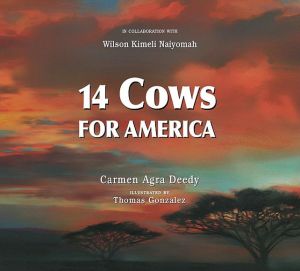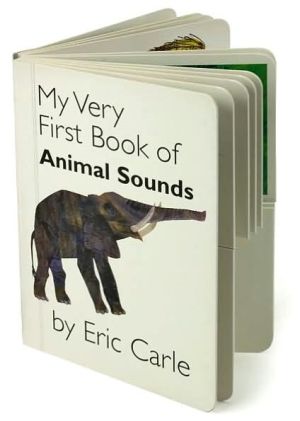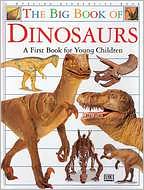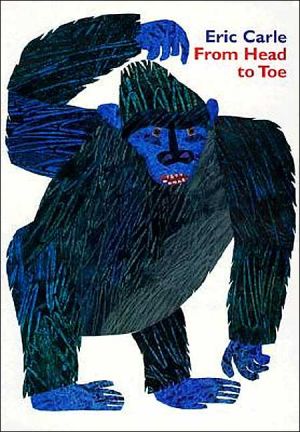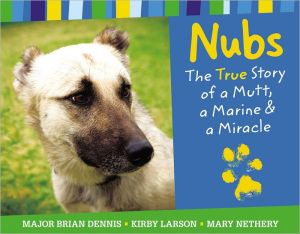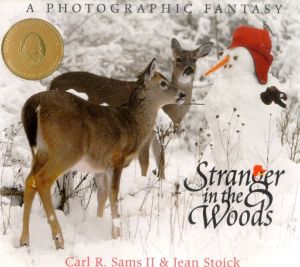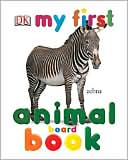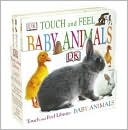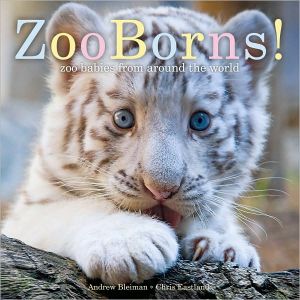14 Cows for America
A New York Times Best Seller This now-classic picture book recounts the true story of a touching gift bestowed on the United States by a tribe of Maasai Warriors in the wake of the September 11th attacks. “Lovely… beautifully evocative.” ―Nicholas Kristof, The New York Times “Moving and dramatically illustrated.” ―The Wall Street Journal “Elegant…suspenseful…The colors of Kenya explode off the page.” ―School Library Journal, STARRED REVIEW In June of 2002, a mere nine months since the...
Search in google:
In June of 2002, a very unusual ceremony begins in a far-flung village in western Kenya. An American diplomat is surrounded by hundreds of Maasai people. A gift is about to be bestowed on the American men, women, and children, and he is there to accept it. The gift is as unsought and unexpected as it is extraordinary. A mere nine months have passed since the September 11 attacks, and hearts are raw. Tears flow freely from American and Maasai as these legendary warriors offer their gift to a grieving people half a world away. Word of the gift will travel news wires around the globe. Many will be profoundly touched, but for Americans, this selfless gesture will have deeper meaning still. For a heartsick nation, the gift of fourteen cows emerges from the choking dust and darkness as a soft light of hope—and friendship. Master storyteller Carmen Agra Deedy hits all the right notes in this elegant story of generosity that crosses boundaries, nations, and cultures. An afterword by Wilson Kimeli Naiyomah—the Maasai warrior at the center of the story—provides additional information about his tribe and their generous actions. Thomas Gonzalez's stunning paintings are saturated with rich hues of oranges and browns and blues and greens, which capture the nobility of the Maasai people and the distinctive landscape of the African plain.The New York Times - Nicholas D. KristofThis is a lovely picture book about foreign aid involving the United States and a remote village in Kenya, but it's not what you think…The illustrations by Thomas Gonzalez are beautifully evocative. They show Kimeli in his Stanford windbreaker and running shoes, surrounded by villagers and, of course, innumerable cows. Over and over in the scenes, two spears or two sticks or even two giraffe necks appear in the background, a subtle echo of the twin towers.
\ Nicholas D. KristofThis is a lovely picture book about foreign aid involving the United States and a remote village in Kenya, but it's not what you think…The illustrations by Thomas Gonzalez are beautifully evocative. They show Kimeli in his Stanford windbreaker and running shoes, surrounded by villagers and, of course, innumerable cows. Over and over in the scenes, two spears or two sticks or even two giraffe necks appear in the background, a subtle echo of the twin towers.\ —The New York Times\ \ \ \ \ Publishers WeeklyA native of Kenya, Naiyomah was in New York City on September 11, 2001. In his and Deedy's (Martina the Beautiful Cockroach) lyrical account, he returns to his homeland and tells the members of his Maasai tribe a story that had “burned a hole in his heart.” The narrative avoids specifics and refers to the events of 9/11 obliquely as the villagers listen to him with “growing disbelief”: “Buildings so tall they can touch the sky? Fires so hot they can melt iron? Smoke and dust so thick they can block out the sun?” Until they read Naiyomah's concluding note, children may not fully comprehend either his story or the villagers' subsequent actions: the tribe elders bless 14 cows, revered in Maasai culture, and symbolically offer them to the American people to help them heal. Featuring luminous images of the Maasai in vivid native dress and sweeping African landscapes, Gonzalez's pastel, colored pencil and airbrush paintings appear almost three-dimensional in their realism. A moving tale of compassion and generosity. Ages 6–10. (Aug.)\ \ \ Children's LiteratureKimeli returns to his small Maasai village for a visit. He has been studying medicine in the United States and he was there during the attacks of September 11. He tells the story to his people and they try to imagine the tall buildings, the deadly fires and the air dark with smoke and ashes. They want to do something for the American people who suffered in the attacks and when an elder voices that sentiment, Kimeli points out the importance cows have to the Maasai. Kimali asks the elder's blessing on offering his only cow but the elders do more than give a blessing. An American diplomat is invited to visit and a splendid ceremony is held as the Maasai offer 14 cows to America. The story is beautifully told and wonderfully pictured. The illustrator captured the African landscape as well as the sense and the feeling of those months after September 11, when the people of the USA were wounded and sad, without ever showing a scene from that day. Kimeli Naiyomah tells his interesting and heartwarming story in detail in a note at the back of the book. Reviewer: Carolyn Mott Ford\ \ \ \ \ School Library JournalGr 2–5—Kimeli Naiyomah returned home to his Maasai village from New York City with news of 9/11 terrorist attacks. His story prompted the villagers to give a heartfelt gift to help America heal. Deedy and Gonzalez bring Naiyomah's story to life with pithy prose and vibrant illustrations. Each block of text consists of a few short, elegant sentences: "A child asks if he has brought any stories. Kimeli nods. He has brought with him one story. It has burned a hole in his heart." The suspenseful pace is especially striking when surrounded by Gonzalez's exquisite colored pencil and pastel illustrations. The colors of Kenya explode off the page: rich blues, flaming oranges, fire-engine reds, and chocolate browns. Full-page spreads depict the Maasai people and their land so realistically as to be nearly lifelike. Gonzalez manages to break the fourth wall and draw readers in as real-time observers. The book's only flaw is the less-than-concrete ending: "…there is no nation so powerful it cannot be wounded, nor a people so small they cannot offer mighty comfort" is an important message, but not a particularly satisfying one for children. Fortunately, their questions will be answered by Naiyomah's endnote, and it provides a fitting conclusion to this breathtaking chronicle.—Rebecca Dash, New York Public Library\ \ \ \ \ Kirkus ReviewsWilson Kimeli Naiyomah is about to return home, to a small village in Kenya. He has been studying to become a doctor in the United States. Amid a joyous homecoming, the children in the village ask if he has brought any stories. He has only one; one that has "burned a hole in his heart." Naiyomah was in New York City on September 11. In gentle yet piercing present-tense prose, storyteller Deedy introduces readers to a young Maasai scholar who wants nothing more than to help a nation heal. In Maasai tradition, cows are sacred, and Naiyomah asks the elders to bless his cow so he can offer it to grieving Americans. In an incredible show of compassion and strength, other villagers join him. Fourteen cows in all, from one tiny Kenyan village, prove that hope and friendship can cross all boundaries. Gonzalez's saturated paintings, glowing with oranges, reds and browns, radiate a warmth that is matched only by the Maasai's generosity. A stirring, heartwarming tale that made headlines when it happened-and is now, thankfully, preserved on the page for children. (afterword) (Informational picture book. 4-8)\ \
